Listed below are examples of projects currently underway or recently completed
Prof. Parmigiani, graduate students Mark McGuire and Eric Shannon, and a number of undergraduates worked with with Blount International—a company that manufactures saw chains and other equipment for the forestry, agriculture, and construction industries—to help make timber harvesters safer.
Timber harvesters look similar to an excavator you might see on a construction site, but instead of a shovel, they have an extendable boom fitted with a large chainsaw and clamp. From the cab of the harvester, an operator controls the boom to grab a tree at its base and cut it off just three or four inches from the ground.
“In the span of 30 seconds, it can take a 100-foot Douglas Fir from standing to 30 or 40-foot logs that can then be loaded onto a truck and taken away,” says Nathan Frechen, a product design engineer in Blount’s forestry product design group.
Occasionally, the saw can run into a rock or piece of equipment, breaking the chain. When this happens, the broken chain can whip out with enough force that a secondary break may occur, potentially sending a short section of chain through the air at speeds exceeding 300 meters per second if not blocked by protective guarding.
These phenomena are rare, but present the potential for serious injury, and Blount is determined to work towards understanding the factors that can lead to their occurrence, and make improvements wherever possible. To do that, they first need to understand exactly what happens when a chain breaks under these circumstances.
Blount reached out to Oregon State to help them figure that out.
“The parameters of the project required that we have a fairly heavy dose of high-level analytical engineering as well as a very capable group of people designing the actual test fixture itself, which seemed to be very well-suited to the OSU [College of Engineering],” said Mike Harfst, director of engineering for Blount’s forestry product design group.

Parmigiani and his group of graduate and undergraduate researchers set out to build an apparatus to simulate a chain break that would eventually be located at Blount’s testing facility.
“We wanted to have an automated test that would be able to simulate those incidents and allow Blount to continue developing safer products for sale in the marketplace,” said Parmigiani. “We designed it so that it used the same components—the same bars, the same chains, the same sprockets – that are used in the field and attached to the machine.”
What they made is a remotely-operated chainsaw inside a shipping container along with various instruments and a high-speed camera. The chain is propelled around a bar until it reaches the desired speed, and then a metal pin is driven into it causing it stop suddenly and break, sending a section of chain through the air where it embeds into the thick plastic walls of the container. The instrument and camera capture data that can them be analyzed. Of course no one is inside the test chamber when the test is conducted. The finished test fixture was shipped to Blount in late 2017 and now resides in their Portland facility.
“We’ll be using [the data collected] to further advance our understanding of the chain-shot phenomenon, then using that to continue developing products,” said Harfst. “We would anticipate that within a couple of years, we will have moved the bar for what constitutes state-of-the-art with these products, which as I said before, is all oriented towards safety.”
“These projects have been great for my research group and for Oregon State,” Parmigiani said. “It’s a way for students to both work on a real-world engineering problem, and really have to take it through to the point it works, but also interacting with the practicing engineers in industry.”
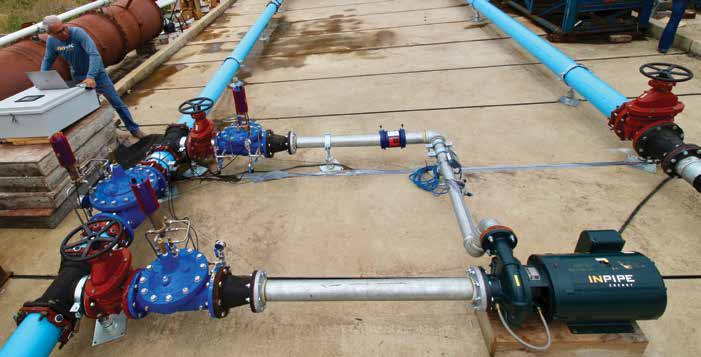
Talk about hydropower usually turns to megastructures such as dams, reservoirs and spillways. With help from Oregon State engineering researchers, an Oregon startup company is developing a system to generate carbon-free electricity from a previously untapped water source: the pipes under our streets. InPipe Energy is taking advantage of the difference in pressure between the major arteries of water distribution networks and the smaller branches that feed homes and businesses. Water suppliers routinely use valves to reduce pressure from high to low, but the energy produced in that step dissipates like heat from a campfire. In a community the size of Corvallis, enough energy might be available in the water system to power the equivalent of 200 homes, says Gregg Semler, company president and CEO. After installation costs, “this is free energy,” adds John Parmigiani, Oregon State professor of mechanical engineering who led a project to test InPipe Energy’s technology. “The idea is to use some of that water to spin a turbine and produce electricity. Water is returned to the system at the right pressure for consumers. They would see no difference in their water pressure. It’s drop-dead simple.” With financial support from Oregon BEST, which supports clean technology research, Parmigiani and Nick Aerne, engineering graduate student, worked with InPipe Energy to design and construct a prototype system at the O.H. Hinsdale Wave Laboratory on the OSU campus. They installed hydropower turbines in a loop parallel to a normal distribution line. At water pressures similar to those found in municipal water systems, they measured power output at startup, under continuous operation and at shutdown. The turbines achieved efficiencies between 60 and 80 percent. “This test proves that InPipe Energy’s hydropower system is safe, reliable, efficient and can be a valuable tool to help water agencies reduce their operating costs and carbon footprint,” Semler says. “We’re using existing infrastructure to produce renewable energy. It’s predictable and low cost and has no environmental impact. Oregon BEST’s investment provided us the capital we needed to build and test our prototype and helped us achieve this critical commercialization milestone.” Operations in the nation’s water infrastructure, including pumping and purification, consume about 6 percent of the total energy used in the United States. In California, where big agriculture distributes vast amounts of water for irrigation and food processing, the energy used approaches 20 percent. Parmigiani and his students are continuing to look at improvements in the technology. Meanwhile, InPipe Energy is in discussions with water agencies and industrial companies on the next phase of commercialization. InPipe Energy tests prototype to generate electricity InPipe Energy’s prototype turbine (lower right) undergoes testing at OSU’s Hinsdale Wave Lab. (Photo: Carolyn Stanley) BY NICK HOUTMAN
Prof. Parmigiani and a series of graduate students: Thomas Wright, Imran Hyder, Mitch Daniels, Levi Suryan, Taylor Rawlings, Kevin Carpenter, and Tim McKinley have been conducted research in the mechanics of carbon fiber laminate composites since 2008. The work, sponsored by the Federal Aviation Administration and Boeing, deals with both finite element modeling and experimentation of structural carbon fiber laminates. Specifically the work has included modeling and experimental studies of out-of-plane bending of notched panels, mode III shear of notched panels, and a focused study of matrix compression.
The images below show the delamination of a carbon fiber laminate under out-of-plane bending loading as observed during experiments (left) and as modeled using finite elements (right)


Investigations of Mode III (out-of-plane shear) loading was conducted on notched panels. Shown below are images of a panel under load (left), finite element modeling of a panel unloaded and loaded (middle), and the notch-tip strain field as calculated by finite element analysis (right).
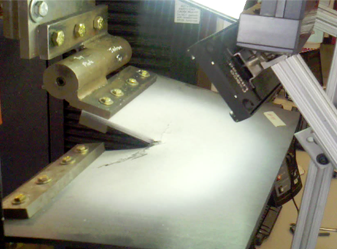
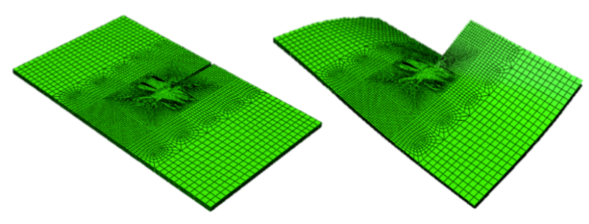
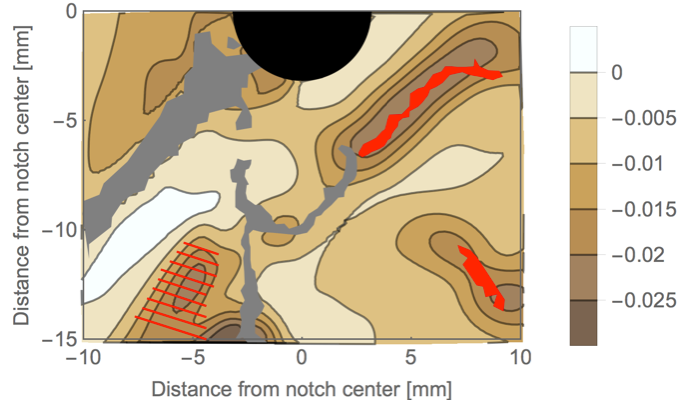
More recent work deals with developing a material model for damage initiation and propagation of the matrix material in carbon fiber laminates when under compressive loading. Shown below are images of the specimen used in the experiments (left), the experimental setup (middle), and the resulting notch-tip shear crack (right).
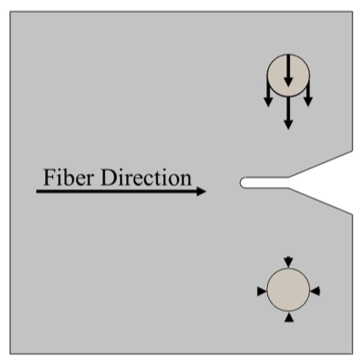
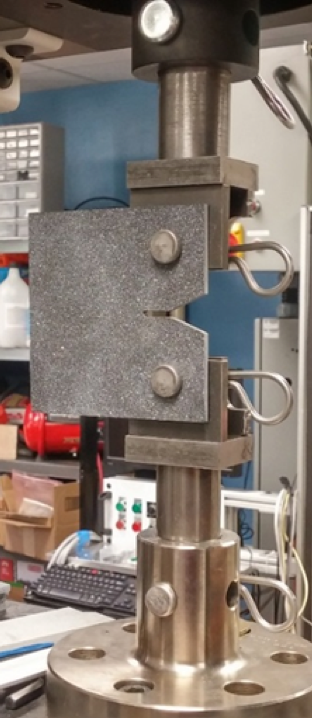
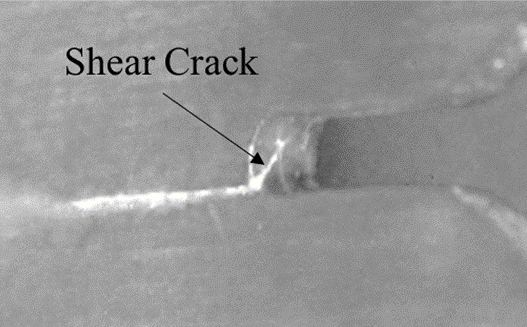
A better understanding of saw chain cutting mechanics is needed for more efficient design of chainsaws. The effects of varying key parameters such as cutting velocity, depth-of-cut, workpiece moisture content, and workpiece density, while established for other types of cutting, are largely unexplored and/or unpublished for saw chain. This paper contributes to filling this gap through experimentation and analysis. Experimentation was conducted using a custom-built saw-chain testing apparatus to measure relevant forces for a range of cutting velocities, depths-of-cut, workpiece moisture contents, and workpiece densities. Analysis consisted of fitting linear regression models to experimental data, identifying trends, and exploring optimum cutting conditions. Results showed that over the range of values included in the study, cutting velocity had a small effect on forces, depth-of-cut a large effect, and moisture content and density each having effects which depended on the depth-of-cut. All trends were fit well with linear models, however depth-of-cut required one linear fit for small-to-mid values and a second linear fit for mid-to-large values. Maximum efficiency was found to occur at a depth-of-cut equal to the transitional value between fits. The results given in this study provide useful information for the more effective and efficient use and design of chainsaws.
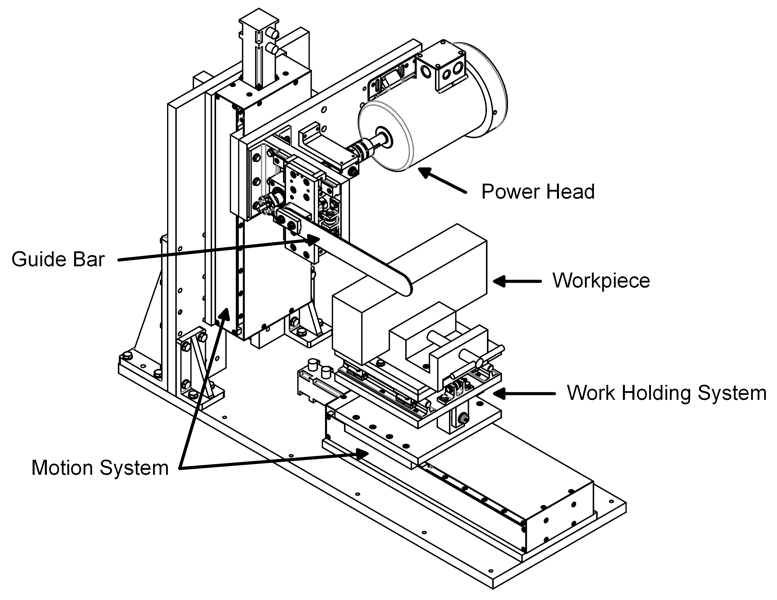
Kickback is the leading cause of the most severe and traumatic chainsaw related injuries. As a result, safety standards require chainsaw manufacturers to produce low-kickback saw chain. In order to understand the tradeoffs in current state of the art saw chain, a comparison study was conducted on a custom test apparatus using four different saw chains, all with the same cutter geometry but different low-kickback chain features. Two modes of cutting were studied: nose-clear down bucking and boring. Cutting performance for boring with a chainsaw has not been studied previously. Regression modelling was used to generate cutting force and cutting efficiency trend lines for each of the different saw chains and cutting modes. In nose-clear down bucking, it was found that operator effort and cutting efficiency of a low-kickback chain with bumper drive links was of near-equal performance to that of a non-low-kickback chain (having no low-kickback features). In boring, all types of low-kickback saw chain elements required markedly higher operator effort and had lower cutting efficiency that of non-low-kickback saw chain. Furthermore, a substantial difference in cutting forces was found between differing designs of bumper drive link elements in both nose-clear down bucking and boring, highlighting the importance of proper bumper link geometry. Using these results and considering that the boring mode of operation is for experienced users, the casual chainsaw operator should always prioritize safety by using a low-kickback saw chain while professional users should select the chain that best suits their current cutting needs.
Chainsaw kickback is a serious safety concern for both experienced and novice operators. A key to developing improved kickback control systems is a better understanding of saw motion during kickback and the development of improved methods for distinguishing kickback from normal saw operation. In this paper accelerometers and gyroscopes are mounted to a battery-powered electric chainsaw and to a mid-size gasoline-powered chainsaw and data collected during normal cutting and kickbacks. These sensors measured accelerations along the guide bar and perpendicular to the bar and rotational velocities toward the operator’s torso. Results from the battery-powered saw showed that accelerations during normal cutting and during kickbacks had peak magnitudes of from ~ 2 g to ~ 6 g and from ~ 6 g to ~ 8 g respectively and that rotational velocities typically reached over 600 degrees-per-second during a kickback. Analysis of these results showed that the gyroscope alone, using a threshold of 300 degrees-per-second, was effective in distinguishing normal cutting from kickback. Results from the gasoline-powered saw showed the same general trends as the battery-powered saw however the rotational velocities during a kickback were greater, typically exceeding 1000 degrees-per-second. Through the use of machine learning techniques, a more effective method than a simple threshold for distinguishing kickback from normal saw operation was developed. Using this method, kickback was determined very reliably and often when the deviations from the rotational velocities corresponding to normal cutting were small. Implementation of these findings could lead to improved kickback control systems on chainsaws.